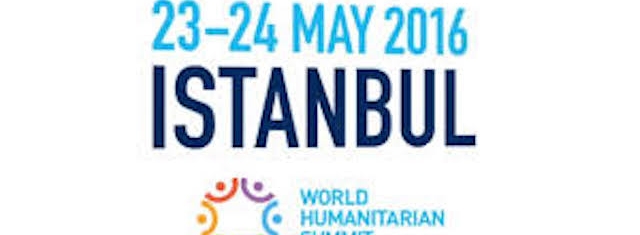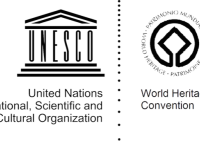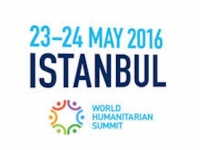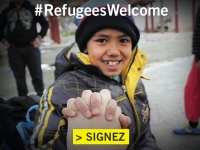Health
Refugee children are five times more likely to be out of school than others
No more Excuses report of UNESCO & UN

World Humanitarian Summit logo (Source: Courtesy World Humanitarian Summit)
USPA NEWS -
A new policy paper, “˜No more excuses´, jointly released by the UNESCO Global Education Monitoring (GEM) Report and UN High Commission on Refugees (UNHCR) ahead of the World Humanitarian Summit on May 23-24 reveals new data showing that only 50% of refugee children are in primary school.
A new policy paper, “˜No more excuses´, jointly released by the UNESCO Global Education Monitoring (GEM) Report and UN High Commission on Refugees (UNHCR) ahead of the World Humanitarian Summit on May 23-24 reveals new data showing that only 50% of refugee children are in primary school and 25% of refugee adolescents are in secondary school.
The paper calls for countries and their humanitarian and development partners to ensure urgently that those forcibly displaced are included in national education plans and to collect better data to monitor their education status and progress.----------------
“There are unprecedented numbers of forcibly displaced populations, putting huge pressure on education systems. But for these children and youth education is especially important: by simply being in school, they are better protected from trafficking, illegal adoption, child marriage, sexual exploitation and forced labour,“ said Irina Bokova, Director-General of UNESCO. Behind the global average number of refugee children out of school, there are significant differences among countries. Primary enrolment rates average 80% in selected refugee sites in Egypt, the Islamic Republic of Iran and Yemen, but only 40% in Pakistan and 50% in Ethiopia.----------------------------------------------------------------------------------------------
Access to secondary education is even more limited for refugees in many countries. In Kenya, Pakistan and Bangladesh, less than 5% of adolescents aged 12 to 17 were enrolled in secondary education. Enrolment in early childhood education also remains very limited in some countries, reaching only 7% in Turkey in 2015.----------------------------------------------------------
"Refugee children, like children everywhere, have the right to education. It is fundamental that children who have been uprooted by war and violence are not left behind even further," said Filippo Grandi, High Commissioner for UNHCR. "We urge donors and development organizations to support efforts to include refugee children and youth in national education systems."Aaron Benavot, Director of the UNESCO GEM Report says collecting information on moving populations is challenging, if not impossible sometimes. “What little we know is mostly about those living in camps, yet more than half of the world´s refugees reside in urban areas, where even less is known. We need to know who they are, what they´ve been through and whether we´re effectively responding to their needs.“Based on available data concerning displaced persons outside refugee camps, the paper shows that only 53% of school-aged Syrian refugees in Jordan and 30% in Turkey are enrolled in school.-
RELIABLE DATA ON INTERNALLY PEOPLE (IDPs) ARE EVEN LIMITED---
Reliable data on internally displaced people (IDPs) are even more limited, but reports indicate that their displacement is putting huge strain on already weak education systems. In Nigeria, for instance, children displaced because of attacks by Boko Haram did not have access to any form of education in 19 out of 42 camps (June 2015 data). In Iraq, only 32% of internally displaced children and adolescents in 2015 had access to any form of education. In Yemen, only one third of school age IDP children in Lahj governorate were enrolled in school.--------------------------------------------------------------------
Those already marginalised, notably girls, are often the worst affected among refugees. In Kakuma Camp in Kenya, in 2015, only 38% of primary school students were girls. In Pakistan, where child marriage and teenage pregnancy are often cited among refugee girls, dropout rates for refugee girls are as high as 90%.------------------------------------------------------------------
Girls and women make up 70% of the world´s internally displaced population and are left the furthest behind in education. In Iraq´s Najaf governorate 81% of 15-17 year-old girls were out of school compared to 69% of boys of the same age. In urban areas in Afghanistan only 1% of IDP women were found to be literate compared to 20% of IDP men.----------------------------
The paper advocates for four main policy directions for governments and their partners to tackle the diverse neglected needs of IDPs and refugees:
1 Enshrine forcibly displaced people´s rights to education in national laws and policy
2 Include displaced children and youth in national education systems
3 Enable accelerated and flexible education options to meet diverse needs
4 Ensure an adequate supply of trained and motivated teachers
Source UNESCO
Liability for this article lies with the author, who also holds the copyright. Editorial content from USPA may be quoted on other websites as long as the quote comprises no more than 5% of the entire text, is marked as such and the source is named (via hyperlink).








